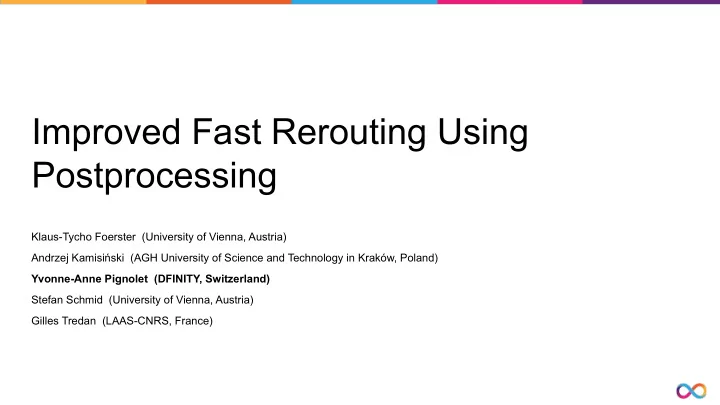

Improved Fast Rerouting Using Postprocessing Klaus-Tycho Foerster (University of Vienna, Austria) Andrzej Kamisiński (AGH University of Science and Technology in Kraków, Poland) Yvonne-Anne Pignolet (DFINITY, Switzerland) Stefan Schmid (University of Vienna, Austria) Gilles Tredan (LAAS-CNRS, France) SRDS 2019 - Improved FRR Using Preprocessing - Y.A. Pignolet
A tale of arborescences and donuts.. ...and their connection to routing 2 SRDS 2019 - Improved FRR Using Preprocessing - Y.A. Pignolet
Outline 1. Model and Objectives 2. Arborescence-based Fast Rerouting 3. Postprocessing Framework 4. Case Studies 5. Conclusion and Outlook 3 SRDS 2019 - Improved FRR Using Preprocessing - Y.A. Pignolet
Motivation Static Fast Rerouting (FRR) ● Seamless failover ● Precomputed failover-routes Approaches for maximal resilience are known [Chiesa et al. TON17] => What about stretch, load and other performance criteria? [CCR18,Infocom19,DSN19] => Despite NP-hardness results and beyond special cases? 4 SRDS 2019 - Improved FRR Using Preprocessing - Y.A. Pignolet
Model and Objectives Model Network: strongly r-connected di-graph No header rewriting, no communication, deterministic In case of failure: static local re-routing based on ● SRC, DST, in-port ● incident failures 5 SRDS 2019 - Improved FRR Using Preprocessing - Y.A. Pignolet
Model and Objectives Model Objectives Load Network: strongly r-connected di-graph Maximum additional link utilization due to rerouting Stretch Maximum additional hops due to rerouting No header rewriting, no SRLG communication, Shared Risk Link Groups deterministic Path independence In case of failure: No shared intermediate nodes to static local re-routing based on destination ● SRC, DST, in-port ● incident failures 6 SRDS 2019 - Improved FRR Using Preprocessing - Y.A. Pignolet
Arc-disjoint Arborescence Decomposition ● Arborescence = a rooted directed spanning tree ● Decomposition: union of r-arborescences uses each link at most once s.t. 7 SRDS 2019 - Improved FRR Using Preprocessing - Y.A. Pignolet
Arborescence FRR ● Assign numbers to arborescences, pick arborescence 1 ● Forward to next hop according to current arborescence 8 SRDS 2019 - Improved FRR Using Preprocessing - Y.A. Pignolet
Arborescence FRR 9 SRDS 2019 - Improved FRR Using Preprocessing - Y.A. Pignolet
Arborescence FRR ● Assign numbers to arborescences, pick arborescence 1 ● Forward to next hop according to current arborescence ● If forwarding link is not available, use link of next arborescence Decomposition influences length/load/.. 10 SRDS 2019 - Improved FRR Using Preprocessing - Y.A. Pignolet
How good is Arborescence FRR? Theorem 1: Deterministic local fast failover algorithms resilient to k − 1 failures, have competitive additive stretch of Ω(n/(k − 1)) (can be met by arborescence-based re-routing on donut graph). 11 SRDS 2019 - Improved FRR Using Preprocessing - Y.A. Pignolet
Improve Decompositions How to transform T1 into T2 ? Observation: outgoing from same node (x,w) ↔ (x,u) (u,v) ↔ (u,x) ... 12 SRDS 2019 - Improved FRR Using Preprocessing - Y.A. Pignolet
Swapping Conditions An arborescence swap e=(u,v) with e’=(u,v’) is valid if I. e ∈ Ti, e’ ∈ Tj and ○ v′ is not on the path from v to the root in Tj ○ v is not on the path from v’ to the root in Ti or II. e ∈ Ti and e’ not in any Tj and ○ v is not on the path from v′ to the root in Ti Observation: Validity computable in O(n) 13 SRDS 2019 - Improved FRR Using Preprocessing - Y.A. Pignolet
Post-Processing Algorithm Decomposition Improved decomposition Objective function Theorem 2. Post-processing algorithm never introduces cycles and always converges. 14 SRDS 2019 - Improved FRR Using Preprocessing - Y.A. Pignolet
Case study 1 Traffic scenario optimization ● Flows differ in size and importance ● Links differ in failure probability => Minimize stretch/load of important flows given a failure model 15 SRDS 2019 - Improved FRR Using Preprocessing - Y.A. Pignolet
Traffic Scenario Stretch Minimization Load Minimization Down to Down 50% ! 0 failures! 50% Down 50% ! lower! 16 SRDS 2019 - Improved FRR Using Preprocessing - Y.A. Pignolet
Case study 2 Direct decomposition optimization ● Shared Risk Link Groups (SRLG) => Links in SRLG in same arborescences ● Path independence => No shared intermediate nodes on routes to destination 17 SRDS 2019 - Improved FRR Using Preprocessing - Y.A. Pignolet
SLRG and Independence SLRG Independence 98 % of paths are independent High % of SRLG links in last arbs 18 SRDS 2019 - Improved FRR Using Preprocessing - Y.A. Pignolet
Conclusions FRR to provide QoS in addition to basic connectivity ● FRR with arborescence decompositions can be asymptotically optimal wrt stretch ● Simple post-processing framework with convergence guarantee Case studies demonstrate applicability for stretch, load, independence, SRLG Future work - Bounds on improvement achieved - Alternative post-processing strategies 19 SRDS 2019 - Improved FRR Using Preprocessing - Y.A. Pignolet
20 SRDS 2019 - Improved FRR Using Preprocessing - Y.A. Pignolet
Post-Processing Algorithm Input : arborescence decomposition T , objective function Output : improved decomposition 1. improved := True 2. while improved do 3. improved := False 4. for each node v do 5. for all pairs of outgoing edges from v do 6. if swapping condition met and objective function improves 7. swap edges in T 8. improved := True Theorem 2. Post-processing algorithm never introduces cycles and always converges. 21 SRDS 2019 - Improved FRR Using Preprocessing - Y.A. Pignolet
Recommend
More recommend